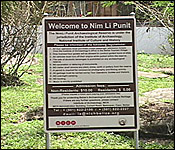
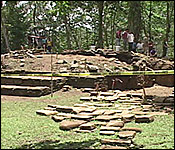

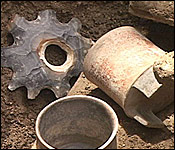
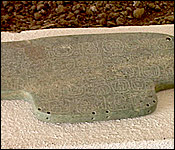
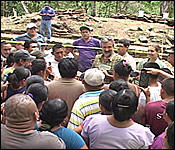 Archaeologists are still buzzing from the very major find that was made 11 days ago at Nim Li Punit in the Toelod District.
Archaeologists are still buzzing from the very major find that was made 11 days ago at Nim Li Punit in the Toelod District.
As we told you last night archaeologists and researchers found 26 ceramic pots and about 8 pieces of jade at the Nim Li Punit Archaeological site about 25 miles away from Punta Gorda. These artifacts were found in tombs on the site.
But there is one particular artifact that has stunned researchers and that's the jade pendant: it is described as the second largest carved piece of jade ever found in Belize and probably in the entire Maya World. Last night we showed you a very brief snippet of the story so tonight we bring you the full feature. We take you to Nim Li Punit where an ancient story is reveled for the first time.
Courtney Weatherburne reporting
Anselmo Cholom has been a Site Ranger here at Nim Li Punit for about 2 years. He takes this stone pathway every day to inspect and maintain the grounds.
It's a small site celebrated in history as the residence of a group of elite Maya families who first settled there between 100 - 250 AD.
There are about 3 main plazas a Ball court used for the scared Maya Ball Game. And what is known as a Counsel House. But Anselmo isn't taking us on a private tour of the site.
He is guiding us to structure 7 which is known as the Royal palace where the Rulers of Nim Li Punit lived.
The female vendors who set up their mini stalls at the entrance of the site along with eager residents from Indian Creek and other surrounding communities followed closely behind.
Mounting flights of winding stairs leading to the Royal residence. They bordered the yellow barricade tape beyond the 2 open tombs - waiting to get a glimpse of what's inside.
Maya Azarova, First year Graduate Student, UCSD - Found it
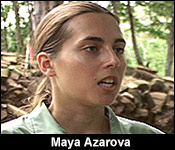 "Maybe it was the 25th, it was like the end of the working day, everyone is already, but then I start cleaning, closing up the unit and then I see something, the earth is starting to fall inside and then like OMG! That must be whole pot and then I cry out and start to do it, then I cry out to Professor Braswell and say, hey have a look there is something here and he said it is 30 minutes until closing are you sure? And I'm like "yes I am totally sure."
"Maybe it was the 25th, it was like the end of the working day, everyone is already, but then I start cleaning, closing up the unit and then I see something, the earth is starting to fall inside and then like OMG! That must be whole pot and then I cry out and start to do it, then I cry out to Professor Braswell and say, hey have a look there is something here and he said it is 30 minutes until closing are you sure? And I'm like "yes I am totally sure."
A team then rushed over immediately and began what would be weeks of excavating to unearth and reveal the mysteries below.
A number of ceramic pots were found, some with the Wind God molded onto the surface.
Others were found broken and the pieces were laid out at the bottom of the tomb on these slabs of cement blocks for display.
What's fascinating about these materials is that some of these artifacts don't originate from any Maya city, but from Mexico.
While that find shocked archaeologists, what was discovered in the 2nd tomb is incomparable.
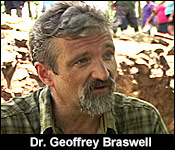 Dr. Geoffrey Braswell, Professor of Anthropology, University of California San Diego
Dr. Geoffrey Braswell, Professor of Anthropology, University of California San Diego
"Working on the palace, the royal residential palace we found an incredible tomb that dates to really early in history here 400 AD and that tomb contained materials from the ancient city of Teotihuacan, North of Mexico City - so very old, totally unexpected and we wanted to come back this year and finish the job and find more and that's when we found our next big tomb."
Courtney Weatherburne
"What I have here is a jade pendant, it was found buried in the tomb and dates back to 671AD. It's about the size of a human heart and was worn by kings around their necks during blood leading ceremonies. While this pendant is a golden find, the story that's etch on the pendant is even more remarkable."
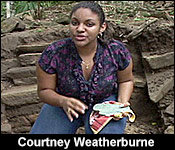 And that remarkable story begins here on this Stela. This is actually an illustration of a king performing a bloodletting ritual with the pendant resting on his chest.
And that remarkable story begins here on this Stela. This is actually an illustration of a king performing a bloodletting ritual with the pendant resting on his chest.
Dr. John Morris
"This is the 3rd series that we have located but it has yielded the most magnificent find I would say within the last 30 years in Belize. The only other find that is equivalent to this is the jade head itself. This is a remarkable piece that I have in my hand here jade pendant which was laid on top of the individual. It's a really remarkable find. In fact this pendant is reminiscence of a pendant that hangs on one of the stela in the visitor center. You can see the individual who actually had the pendant on his chest and we think that it is the same."
Dr. Geoffrey Braswell
"Well it is significant in many ways, first of all its date, it's really late, we didn't expect to find a tomb so rich during the time period of the Maya collapse, so things were still pretty good here at Nim Li punit, second I think we have to say the most important thing it is the second largest piece of carved Maya jade in Belize and maybe even in the Maya world I have to go look in Mexico and Guatemala and other parts but this is a very large piece."
"It was brought here, it wasn't made here, it was brought here from Caracol in the Cayo District by a Lord of Caracol who came here to what was a much smaller site to celebrate what was an important event on the calendar, an important almost like what was a century change on the calendar and to perform a sacrificial ritual, so the jade talks about him, his name was Janaab K'inich and he was the lord of Caracol, it talks about his mother whose name was the Holy Lady and she is even said it have 5 slaves and his father is mentioned and it says here that he came to do this ritual, Now what is interesting about that is that tells us that the Lords here had very powerful relations with Caracol, we did not know that before because there is no other way to tell from the artifacts here or from the other hieroglyphics - so he came from Caracol and made a visit, kind of like when Queen Elizabeth comes to Belize."
A Royal visit: that must have been what it felt like for the villagers as Dr. Braswell descended from the platform flanked by his team. He emerged from the behind the barricade tape towards them, with the jade pendant clutched in his hand.
Residents huddled together to capture this moment, to get a glimpse, a snapshot of this jade piece brought before them. And for the first time since its discovery, the story was told and translated to the Maya people:
Dr. Geoffrey Braswell
"He came to do a scattering event. That's a ritual, a sacrifice. That is in AD671 after Christ. His name Janaab ol K'inich, he was the child of the holy lady. This side of the back is a T which means wind or breathe."
An eager grasp or a gentle glide of fingers over the pendant: gestures of adulation and reverence.
This artifact revels a story that has been hidden for centuries. For these villagers it's direct connection to their ancestry and for the archaeologists it exposes a connection they didn't even know existed?
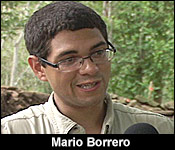 Mario Borrero, First year Graduate Student, UCSD
Mario Borrero, First year Graduate Student, UCSD
"Archeologically, it has a lot of history, a lot of meaning for us, as we said the jade is really nice, it is beautiful but the story that is written on it is important piece of history that was lost and now we found it again and that connection we see between Nim Li Punit and Caracol that's really excellent."
Dr. John Morris
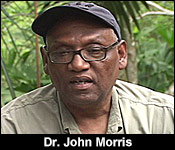 "The one thing that strikes me immediately is that most often times when we talk about the ancient Maya, we don't really hear about the stories of the individuals. You hear about the story of the site themselves, Tikal, Caracol, Palenque. We are just beginning to flesh out their narratives for these people. Who are these people? What's their life like? You read roman history, you read Chinese history - ancient Chinese history. You talk about this emperor and that emperor, but in the Maya era, we've just beginning to be able to decipher these glyphs and talk about people and so now here we have an individual, we have his name, we have where he came from, what type of alliance this was. So we can begin to build a chronology. We can begin to build stories."
"The one thing that strikes me immediately is that most often times when we talk about the ancient Maya, we don't really hear about the stories of the individuals. You hear about the story of the site themselves, Tikal, Caracol, Palenque. We are just beginning to flesh out their narratives for these people. Who are these people? What's their life like? You read roman history, you read Chinese history - ancient Chinese history. You talk about this emperor and that emperor, but in the Maya era, we've just beginning to be able to decipher these glyphs and talk about people and so now here we have an individual, we have his name, we have where he came from, what type of alliance this was. So we can begin to build a chronology. We can begin to build stories."
According to archaeologists there is still a lot to find at the site. The jade pendant will be stored at the Central Bank along with the iconic Jade Head.



